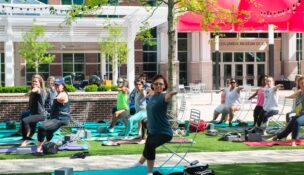C.W. Bowman was a ‘tunnel rat’ in Vietnam. Hear about it at the Relic Room
CRBR Biz Wire //June 13, 2023//
C.W. Bowman was a ‘tunnel rat’ in Vietnam. Hear about it at the Relic Room
CRBR Biz Wire //June 13, 2023//
 COLUMBIA, S.C. – In some parts of Vietnam, the Viet Cong lived for months at a time under the Earth, in elaborate tunnel systems so sophisticated that they included hospitals, training areas, and storage facilities as well as barracks. But from the surface, they just looked like holes in the dirt that only a snake would crawl into. And sometimes there were snakes there.
COLUMBIA, S.C. – In some parts of Vietnam, the Viet Cong lived for months at a time under the Earth, in elaborate tunnel systems so sophisticated that they included hospitals, training areas, and storage facilities as well as barracks. But from the surface, they just looked like holes in the dirt that only a snake would crawl into. And sometimes there were snakes there.
But during the Vietnam War, American soldiers had to slither into them, alone, with nothing but a flashlight and a .45-calibre pistol, and search for the enemy. These rare volunteers were called “tunnel rats.” And C.W. Bowman was one of them.
Bowman will return to the South Carolina Confederate Relic Room and Military Museum in Columbia on Friday, June 30, to tell what it was like, in a free lecture at noon. His program, “Tunnel Rats of Vietnam,” is part of the museum’s monthly Lunch and Learn series and is open to the public.
He’s been to the Relic Room before. He delivered his lecture at the museum four years ago, and it was well received. Now, you can find photos of him honoring his service in the major new exhibit, “A War with No Front Lines: South Carolina and the Vietnam War, 1965-1973.” Bowman retired in the community after serving as a drill sergeant at Fort Jackson. He’s originally from Bordentown, N.J., but has called South Carolina home since 1973.
He was drafted into the Army when he was 19, and first went to Vietnam at the start of 1967. When he was there, he weighed 138 pounds, and had a 28-inch waist. Today, people sometimes look at him and laugh when he says he was a tunnel rat, because those guys had to be skinny, and he’s more like 200 pounds now. He just tells them they’ve probably gained a little since 1967, too.
How did he get to be a tunnel rat? One day his sergeant told him to check out a VC bunker, just underground. He went into the dark chamber with his heart in his mouth. All he could see was the light at the other end of the bunker, so he headed straight for it, telling himself if he made it, he would live. His adrenaline was pumping like crazy, but he made it. When he got out, he thought, “That was pretty cool.”
Some of the bunkers were connected by tunnels, so Bowman told another soldier that if he would check the bunkers, Bowman himself would take the tunnels. And so, he became a “rat,” from then on. It was best to entrust such a task to a volunteer with experience.
Units that had no such experts would generally just drop a grenade down the tunnel and moved on. Which raises the question, why climb down in there at all? Bowman has a short answer: “Intelligence.” One time, he brought up a map showing VC camps all over the area, and his unit’s operation was extended another two weeks, checking them out. His buddies showed their appreciation by saying, “Next time you find a map, leave the son of a bitch in the tunnel.”
He has lots of other stories, good ones. Come hear them at the Relic Room on June 30.
About the South Carolina Confederate Relic Room and Military Museum
Founded in 1896, the South Carolina Confederate Relic Room and Military Museum is an accredited museum focusing on South Carolina’s distinguished martial tradition through the Revolutionary War, Mexican War, Civil War, Spanish-American War, World Wars I and II, Vietnam, the War on Terror, and other American conflicts. It serves as the state’s military history museum by collecting, preserving, and exhibiting South Carolina’s military heritage from the colonial era to the present, and by providing superior educational experiences and programming. It recently opened a major new exhibit, “A War With No Front Lines: South Carolina and the Vietnam War, 1965-1973.” The museum is located at 301 Gervais St. in Columbia, sharing the Columbia Mills building with the State Museum. For more information, go to https://crr.sc.gov/.
-












